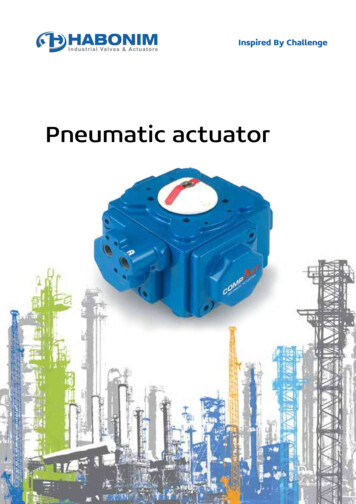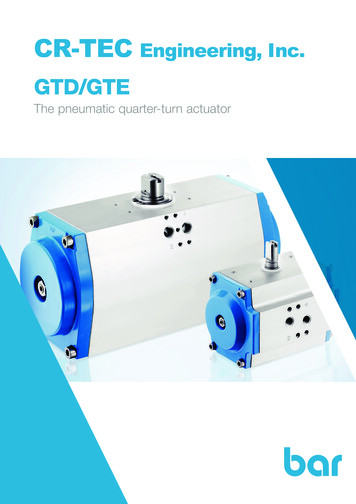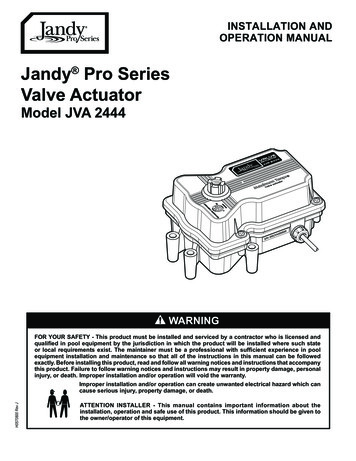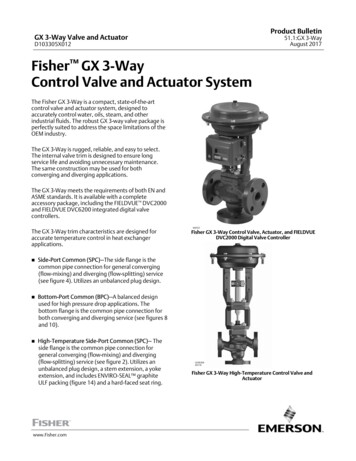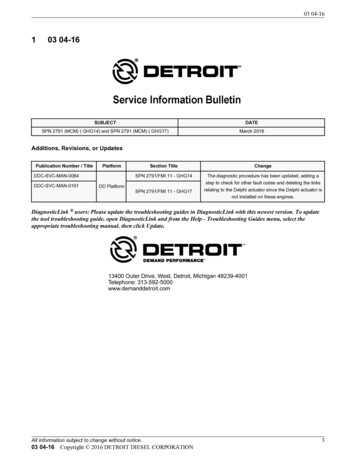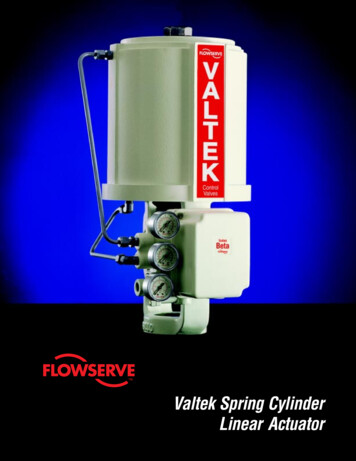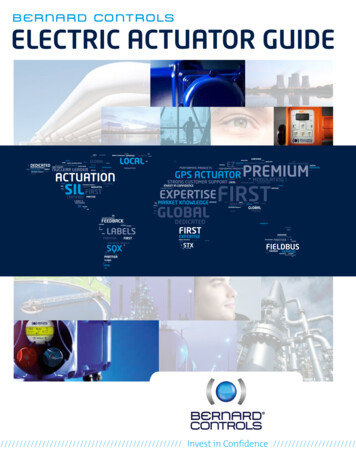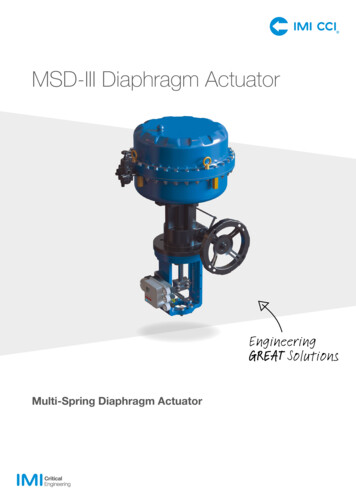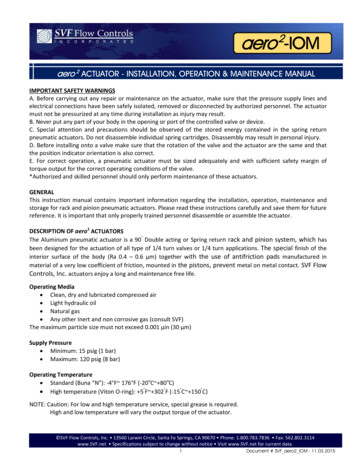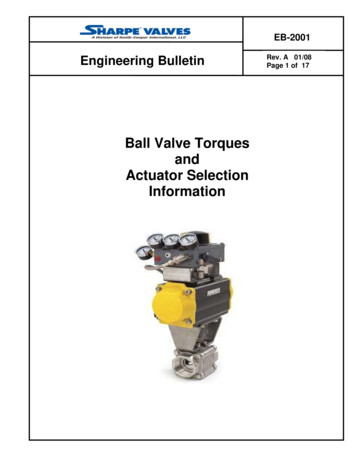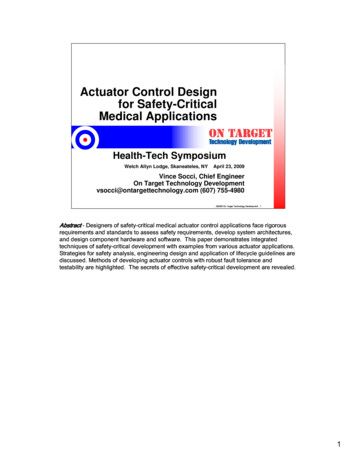
Transcription
Actuator Control Designfor Safety-CriticalMedical ApplicationsHealth-Tech SymposiumWelch Allyn Lodge, Skaneateles, NYApril 23, 2009Vince Socci, Chief EngineerOn Target Technology Developmentvsocci@ontargettechnology.com (607) 755-4980: 2009 On Target Technology Development1Abstract - Designers of safety-critical medical actuator control applications face rigorousrequirements and standards to assess safety requirements, develop system architectures,and design component hardware and software. This paper demonstrates integratedtechniques of safety-critical development with examples from various actuator applications.Strategies for safety analysis, engineering design and application of lifecycle guidelines arediscussed. Methods of developing actuator controls with robust fault tolerance andtestability are highlighted. The secrets of effective safety-critical development are revealed.1
Stupid is as stupid does. -- Forrest GumpEventually, everyone screws up and everything breaks.If your world is void of failures, you don’don’t need to be here.But if safetysafety-related failures worry you, stick around. 2009 On Target Technology Development Page 22
Ready for the Ride? Roadmap Problem: Rigorous industry standards to assesssafety requirements, develop system architectures,and design component hardware and software. Integrated techniques of safety-critical development Strategies for engineering design and application Methods of robust fault tolerance and testability Effective safety-critical development tips Your Guide Vince Socci – BS EE, MS EE, MBA TM Principal, On Target Technology Cross-disciplined – systems, hardware, softwareengineering Electronics design and embedded controls 2009 On Target Technology Development Page 3Speaker Background – VPS, OTTD, we do PD&M, R&D TS,Vincent Socci is a cross-disciplined systems, hardware and software engineer. Histechnology expertise includes embedded systems, sensors and signal processing, powercontrol systems, and diagnostics. Socci has 20 years of experience in safety-criticalsystems development. He holds an MBA in technology management, and MS and BSdegrees in electrical engineering. As Principal of On Target Technology Development,Socci supports clients with electronics design and embedded controls development. He hasapplied the safety-critical design concepts presented in this paper in medical, aerospace,automotive, locomotive, and industrial applications.3
Agenda Fundamentals of Safety-Critical Systems Actuator Control Design from a Systems Perspective Industry Specifications and Standards Development Strategies Example Cases Conclusions Questions and Answers 2009 On Target Technology Development Page 44
Industrial Trends in Safety-Critical Systems Medical Growing focus on safety development standards Sensitive to failure, development cost/time,marketability, global competition Aerospace Long history of fly-by-wire and other x-by-wireactuator control systems Long development, low volume, expensive safetycritical applications. Automotive Emerging x-by-wire needs Short development, high volume, cost-efficient safetycritical applications. Demand for fault tolerance, speed-to-market & low cost. 2009 On Target Technology Development Page 55
Fundamental Concepts ofSafety-Critical Systems 2009 On Target Technology Development Page 66
Fundamental Concepts of Safety-CriticalSystemsScenario:Imagine sitting comfortably on an airplane, enjoying a newissue of your favorite magazine. All of a sudden, as youfly over the Equator, the plane does a fast 180-degreeroll, and you find yourself in an inverted flight. The pilotannounces over the loudspeaker “Hmmm that doesn’tseem right. Are there any systems engineers onboard?”The software development for the F-16 fighter planeexperienced this exact failure mode during simulationflight testing. It was resolved in the fielded design.If this failure occurred in realreal-life,the aircraft and pilot would be lost. 2009 On Target Technology Development Page 7Sound far fetched?7
Other F-16 Simulation Failures When the computer was commanded to raise thelanding gear while the aircraft was standing still on therunway, the computer complied and “turfed” the aircraft. The aircraft system also complied with commands tojettison missiles, bombs, fuel tanks, etc. while the planewas upside-down, resulting in them falling on anddamaging the wings. When the F-16 went into a spin, the software did notgive the pilot enough control authority to recover. Thepilot had to eject.Failures like this put lives and property at risk.We can’can’t let them happen – period. 2009 On Target Technology Development Page 88
Safety-related vs. Safety-Critical Safety-related systems – those in which a failure during operationcan have serious or irreversible effects – such as loss of life or limb,severe property damage or financial losses. (e.g. insulin pump) Safety-critical systems – safety-related systems that present adirect threat to human life. They can include aircraft controlsystems, medical instrumentation, railway signaling, nuclear reactorcontrol systems and many other applications. Safety-critical systems include all of the components that worktogether to achieve the safety-critical mission. These may include input sensors, digital data devices, hardware,peripherals, drivers, actuators, the controlling software, andother interfaces. Their development requires rigorous analysis andcomprehensive design and test. 2009 On Target Technology Development Page 99
Managing Design / Controlling Operation Failures occur in development and operation. Failures in development can be mitigated, but failures inoperation are unavoidable. Stuff breaks! Effects of these hardware failures must be predictable(i.e. deterministic) and not catastrophic. Design to consistently maintain and control the safety ofthe system when failures occur.Robust Design Controlled Operation Safe Mission Safe actuator control is guaranteed only through robustdesign (error-free) and robust operation (fault-tolerant). 2009 On Target Technology Development Page 10Safety-related failures can occur in development or in operation. The design may be weakor not robust enough for the operating environment. Design standards and practices,including rigorous requirements management, engineering analyses, design reviews andtesting can support validation of the design.Failures in operation are unavoidable. Stuff breaks! Whether it’s a wire in a harness or aworn-out relay – hardware will eventually fail. Safety-critical systems are designed suchthat the effects of these hardware failures are predictable (i.e. deterministic) and notcatastrophic. Architectures are designed to consistently maintain and control the safety ofthe system when failures occur.Robust Design Controlled Operation Safe MissionRemember that safe actuator control is guaranteed only through robust design and robustoperation. Design robustness is achieved through robust processes and engineeringdesign practices. Controlled operation is achieved by thorough monitoring, fault detectionand mitigation strategies.10
Safety-Critical Medical Actuator Examples Hospital beds Ambulatory scooters Patient lifts Pumps and valves for drug delivery X-ray controllers Massage therapy Prosthetics Laparoscopic tools Etc.Monitors are passive,but actuators are active. 2009 On Target Technology Development Page 1111
Actuator Control Designfrom a Systems Perspective 2009 On Target Technology Development Page 1212
Actuator Control System Block terface An operator uses the control interface to stimulate the control system. Control algorithms drive an output to the actuator, which moves the mechanical interface. A feedback response of the mechanical interface is collected through feedback sensors. Signal conditioning is applied to inputs and outputs to convert raw signals to usable forms. 2009 On Target Technology Development Page 13This paper focuses on actuator control systems because these applications provide arelevant mixture of hardware and software functions that integrate the broad requirementsof safety-critical systems. Consider the following system block diagram of an actuatorcontrol system.Most of these control system functional blocks are hardware functions, implemented bysome mechanical or electrical components. The control algorithms are typically softwarefunctions, implemented by a computing program installed to and operating on a processingdevice. Signal conditioning can occur in both hardware and software.13
Built-In-Test (BIT) Built-in-test (BIT) validates interfaces and controlvariables. Verify integrity of system before, during and after use. BIT analysis is part of the design process of a safetycritical system. Considers potential failures throughout the systems Verifies that these failures will be detected andmitigated by the BIT functions. Ex. If a power source is lost, BIT should detect thefailure and respond by ensuring that the systemresponds in a safe manner. 2009 On Target Technology Development Page 14Controllers generally use some form of built-in-test (BIT) to validate interfaces and controlvariables. BIT is designed to detect failures in any of the system elements. BIT is theprimary means to verify the integrity and operation of system and hardware componentsbefore, during and after the mission.Systems engineers typically perform a BIT analysis as part of the design process of asafety-critical system. This BIT analysis considers potential failures throughout the systemsand verifies that these failures will be detected and mitigated by the BIT functions.Forinstance, if the power source of Figure 2 fails (e.g. loss of power), BIT should detect thefailure and respond by ensuring that the system responds in a safe manner.14
BIT Software vs. Hardware Safety-critical systems are becoming more complex. Role of software is becoming more dominant for bothcontrol and monitoring. BIT can be implemented in hardware or software form. Software implementation of BIT functionality is preferred. Hardware is subject to failure, resulting in false positiveor false negative failure detection. Hardware that implements BIT functions should notreduce reliability or system safety. 2009 On Target Technology Development Page 15As safety-critical systems are becoming more complex and computer-controlled, the role ofsoftware is becoming more dominant for both control and monitoring. BIT functionality canbe implemented in hardware or software form. Software implementation of BIT functionalityis preferred. Hardware that implements BIT functionality can itself be subject to failure,resulting in false positive or false negative failure detection. Engineering design practicessuggest that hardware that implements BIT functions should not reduce reliability or systemsafety.15
Controller Implementation of a SimpleActuator Control SystemController HardwareController Software (and Core Hardware)Real-Time Operating SystemData Communication and ditioningActuatorFeedbackInterfacesBuilt-InTest 2009 On Target Technology Development Page 16Now let’s consider a simple actuator system from the perspective of controllerimplementation. This figure provides a general block diagram of controller implementation.The arrows represent a simplified functional flow for the actuator. Actual data flow can bemuch more complex. Refer to the figure for the following discussion.16
External Interfaces The following interfaces areexternal to the controllerhardware: Actuator Input interfaces Feedback interfaces. Near controller or far away Connected through wireharnesses, or wireless Susceptible to hardware failuresController HardwareController Software (and Core Hardware)Real-Time Operating SystemData Communication and putSignalConditioningActuatorFeedbackInterfaces 2009 On Target Technology Development Page 1717
Controller Hardware Includes: I/O signal conditioning peripheral interfaces core processing platform.Signal conditioning: Converts the input signals forthe core processor Translates processor outputsinto driver signals for theactuator. Peripheral hardware may includewatchdog monitors, protectivedevices etc. Processing platform includes theprocessor, memory, and anyother devices needed to supportprocessing operation.Controller HardwareController Software (and Core Hardware)Real-Time Operating SystemData Communication and putSignalConditioningActuatorFeedbackInterfaces 2009 On Target Technology Development Page 18The controller hardware provides I/O signal conditioning, peripheral interfaces and a coreprocessing platform. Signal conditioning converts the input signals into forms that can beinterpreted by the core processor, and translates processor outputs into driver signals forthe actuator. These driver signals may be high current signals that directly drive theactuator or they can provide indirect control of an external power source, as shown inFigure 2.Peripheral hardware may include watchdog monitors, data communicationdevices, power converters, protective devices and filters, configuration hardware and otherperipheral hardware. The core processing platform includes the processor, memory, andany other devices needed to support processing operation.18
Controller RTOS Real-time Operating Systemsperform: executive management task scheduling other operating utilitiesExamples: Ad-hoc operating system Commercial off-the-shelfRTOS:– Integrity, VxWorks, LynxOS– Must be certifiable to thesafety criticality level of theapplication.Controller HardwareController Software (and Core Hardware)Real-Time Operating SystemData Communication and putSignalConditioningActuatorFeedbackInterfaces 2009 On Target Technology Development Page 19Controller software, which resides and operates on the core hardware, has a real-timeoperating system (RTOS) that performs all executive management and task scheduling, aswell as other operating utilities. This may be an ad-hoc operating system, or it can be acommercial off-the-shelf RTOS, such as VxWorks, CsLEOS or Integrity, that is certifiable tothe safety criticality level of the application.19
Input/Output Signal Processing Input signal processing Read raw data from inputhardware Massage into usable form– Software filters– Discrete debouncing– Range detection.Output signal processing Create physical signals todrive to hardware. Timing or filtering of outputdriversController HardwareController Software (and Core Hardware)Real-Time Operating SystemData Communication and putSignalConditioningActuatorFeedbackInterfaces 2009 On Target Technology Development Page 20Input signal processing software reads raw data inputs from the hardware and massagesthem into usable form for the software algorithms. This massaging includes software filters(e.g. lag and lead filters), discrete debouncing, and range detection. Output signalprocessing converts the results of the control algorithms into physical signals to drive tohardware.20
Control Algorithm Processing Provides the heart of the actuatorcontrol functionality.Control data and variables areread and processed todeterministically drive the realtime response of the actuator.Critical real-time and frequencydependent algorithmsController HardwareController Software (and Core Hardware)Real-Time Operating SystemData Communication and putSignalConditioningActuatorFeedbackInterfaces 2009 On Target Technology Development Page 21Control algorithms provide the heart of the actuator control functionality. This is where theplant models, control loops and decisions are processed. Control data and variables areread and real-time algorithms are processed to deterministically drive the appropriate realtime response of the actuator.21
Data Communications and Management Manipulate the data associatedwith the inputs and outputsProvides any processingassociated with redundancy orcross-channel communication. Multichannel Datasets(copies) Data synchronization Self and cross-channel BIT.Controller HardwareController Software (and Core Hardware)Real-Time Operating SystemData Communication and unt of data that must bemanaged can become huge andcoordination can becomecomplex. 2009 On Target Technology Development Page 22The data communication and management functions manipulate the data associated withthe inputs and outputs, including digital communication to external components. Thesefunctions also provide any processing associated with redundancy or cross-channelcommunication. For example, a quad-redundant actuator system would have a completeset of data for each of the four channels. Some level of data synchronization is needed tomaintain coordinated control of the four channels. Each channel may perform BIT on itselfand one or more of the other channels. Depending on the intricacy of data communication,the amount of data that must be managed can become huge and coordination can becomecomplex.22
Built-In-Test BIT functions detect faults andisolate them to individualcomponents or small groups.Detection Test during operationand compare results to expectedvalues. Isolation Determine if the faultoccurred inside the controller orexternal interfaces. Test all faults that have an effecton the safe operation of themission.Controller HardwareController Software (and Core Hardware)Real-Time Operating SystemData Communication and putSignalConditioningActuatorFeedbackInterfaces 2009 On Target Technology Development Page 23Actuator controls include BIT functions to detect faults and isolate them to individualcomponents or small groups of them. Failure detection is usually accomplished byconducting a series of tests during operation and comparing results to expected values.Isolation logic determines if the fault occurred inside the controller or was the result ofexternal interfaces. The designer’s goal is to test any potential fault that has an effect onthe safe operation of the mission in the appropriate mode of BIT.23
BIT Modes BIT can be categorizedinto the following modes: Power-up BIT (PBIT) Continuous BIT (CBIT) Initiated BIT (IBIT) Each safety-critical fault istested in one or more ofthese BIT modes Each BIT mode mayperform a subset (orsuperset) of another BITmode Fault thresholds,persistence limits andscheduling of individualBIT are coordinated toreject false failureindications.CBITCommonBITPBITIBIT 2009 On Target Technology Development Page 24Nested acronyms24
Power-up BIT (PBIT) Also known as Start-up BIT Executes on application of power Rapid check of ability to operate Examples Core processing failure – themission can be halted beforeoperator safety is jeopardized Actuator feedback interfacefailure – the actuator may notbe controllable, and themission would be aborted Scope of PBIT testing dependson application power uprequirements. Designers must trade-off PBITtest coverage with PBIT timingconstraints.CBITPBIT IBITSample PBIT Tests: Processor diagnostics Memory Configuration Watchdog timeout Power supply voltage Interrupts Critical I/O 2009 On Target Technology Development Page 2525
Continuous BIT (CBIT) Also known as Periodic BIT Provides continuous monitoringof all system components. Minimizes failure exposure time. Example: Current feedback on adrug pump actuator detects if theflow is obstructed duringoperation. CBIT completion time must beconsidered when the maximumfailure exposure time (themaximum time between when afault occurs and when the fault isdetected and mitigated) iscritical.CBITPBIT IBITSample CBIT Tests: Subset of PBIT tests Control Sensors Control Discretes Feedback Sensors Feedback Discretes Dynamic responsiveness Data communication validation Actuator current monitors 2009 On Target Technology Development Page 2626
Initiated BIT (IBIT) Also known as Maintenance BIT,or other alternative names. Extensive set of tests, initiated bythe operator, which occurs whenthe system is in a stable, knownenvironment. The environment must becontrolled because control of theactuator is given to the BITfunctions rather than the normalcontrol algorithms. Example: range test on anactuator IBIT completion time is typicallylong because it performscomprehensive, full-range testsCBITPBIT IBITSample IBIT Tests: Superset of PBIT and CBIT tests Power system tests Dynamic actuator tests Mechanical range tests Initiated failure tests 2009 On Target Technology Development Page 27Suppose an actuator moves a swing-arm from 0º to 180º. The system cannot test the fullrange of motion during operation, unless the application guarantees to move the swing-armover its full range of motion during the mission. The operator can use a special controlledtest in IBIT to verify that the swing-arm can operate over its full range of motion.27
BIT Analysis Leverages results of other system safety analyses,including: Preliminary System Safety Assessment Fault Tree Analysis Failure Modes and Effects Analysis Consider failure mode, probability of failure, cause andeffect, recognition/detection scheme, isolation, systemcompensation Will typically yield action items for design improvements. Not a “do it once checkbox” – Analysis is incrementaluntil requirements are satisfied. 2009 On Target Technology Development Page 2828
Redundancy Failures are mitigated by theother operating channels,perhaps with a degraded levelof performance. The effects of failures in nonredundant components, suchas the control interface andpower source, cannot sSensorMonitorsSensorMonitorsMonitors 2009 On Target Technology Development Page 29Redundancy is a common design practice that is often used to maintain functionality after afailure occurs.In this case, functionality is maintained by four redundant operating channels. Failures thatoccur in a controller, actuator or mechanical monitor can be mitigated by the otheroperating channels, perhaps with a degraded level of performance. The effects of failuresin non-redundant components, such as the control interface and power source in this case,cannot be alleviated.29
Degradation Categories for Failure Response Fail-Operational – From anoperator perspective, the systembehaves normally. Failure is reported, butsystem operation isunaffected. System components thatremain functional typicallytake over the functions of thefailed components. Example: Dual-redundantsurgical blood flow systemstypically can meetperformance requirementswith only one channel. Whenone channel fails, the systemcontinues to perform usingthe remaining orMonitorsSensorMonitorsMonitors 2009 On Target Technology Development Page 30There are many failure modes, but system designers have developed approaches to mitigate them.Various response categories have been developed to describe mitigation of these system failures:Fail-Operational – From an operator perspective, the system behaves normally. The failure isreported, but system operation is unaffected. The system components that remain functionaltypically take over the functions of the failed components. Example: Quad-redundant flight controlsurface actuator systems typically can meet performance requirements with only three channels.When one channel fails, the system continues to perform using the remaining three channels.30
Degradation Categories for Failure Response Fail-Passive – Outputs assume apredetermined desirable state,such as a power disconnect tothe actuators. Failure is reported, andoperation is reverted tobackup. Intervention may be required,but the system remains undercontrol in some degradedfashion. Example: Ambulatory scooterused reduced speed modewhen battery supply is low.The vehicle will not maintaindesired performance, butrider can “limp” onitorsSensorMonitorsMonitors 2009 On Target Technology Development Page 31Fail-Passive – The system outputs a predetermined desirable state, such as a power disconnect to theactuators. The failure is reported, and operation is typically reverted to a backup mechanism.Intervention may be required, but the system generally remains under control, although usually insome degraded fashion. Example: Many marine actuator control applications provide amechanical backup that is automatically engaged when automated systems fail, thereby enablingthe pilot to “limp home”. The vehicle may not meet performance requirements, but it will be able totravel to a safe environment.31
Degradation Categories for Failure Response Fail-Safe – Provides a saferesponse when normal,predictable control is notpossible. Subcategory of fail-passive Actuators are not controllablein a manner to meet theperformance specification. System employs mechanismsto force the actuator in aknown state that maintains asafe operational state. Example: Patient lift backupis engaged when automatedsystems fail, holding patientsafely. The lift will not meetperformance requirements,but it will maintain a torsSensorMonitorsSensorMonitorsMonitors 2009 On Target Technology Development Page 32Fail-Safe – This approach is used to provide a safe response when normal, predictable control is notpossible. In this category, which is sometimes considered a subcategory of fail-passive, theactuators are not controllable in a manner to meet the performance specification. However, thesystem employs mechanisms to force the actuator in a known state that maintains a safeoperational state. Example: Hybrid-electric vehicles (HEV) have experienced failures that cause“runaway motors” where motors speed up out of control and transfer uncommanded power to thedrive axles. A fail-safe mitigation would disconnect power from the motor, usually through highcurrent relays, when a failure occurs. The vehicle may not be drivable, but the passengers andcargo remain safe.32
Degradation Categories for Failure Response Fail-Active – Highly undesirablestate occurring when mitigationinto one of the other categories isnot possible. Applications allow a smallprobability, such as 10-9. Actuators respond in anuncontrollable/unpredictable(nondeterministic) manner. Safety-critical systems aredesigned to minimize failactive scenarios. Example: Automotive steerby-wire applications havesteering wheel interfaces withcommon mode failures thatcould inhibit steering orMonitorsSensorMonitorsMonitors 2009 On Target Technology Development Page 33Fail-Active – This category is highly undesirable and strikes fear into the hearts of safety-criticalsystems designers. It occurs when mitigation into one of the other categories is not possible. Itcannot be prevented completely, so applications typically allow a small probability, such as 10-9.In a fail-active state, actuators drive the system in an uncontrollable and unpredictable(nondeterministic) manner. Safety-critical systems are designed to minimize fail-active scenarios.Example: Automotive steer-by-wire applications have a unique challenge in that typical steeringwheel interfaces have common mode failures that could inhibit steering control.33
Degradation Requirements Performance specs apply degradation categoriesthrough multiple failure modes. Example for a tri-redundant artificial heart: After the first failure, the system shall remain failoperational. After the second failure, the operation shall be failpassive. After the third failure, the operation shall be fail-safe. Select architectures and components to meet theserequirements. In this example, the heart must be able topump with only two operating channels. The actuatorsmust be sized to enable operation with only twofunctioning actuators. 2009 On Target Technology Development Page 34Application performance specifications may require system architecture
Commercial off-the-shelf RTOS: - Integrity, VxWorks, LynxOS - Must be certifiable to the safety criticality level of the application. Controller Software (and Core Hardware) Input Interfaces Signal Conditioning Input Signal Processing Output Signal Processing Signal Conditioning Feedback Interfaces Control Algorithm Processing Built-In Test
